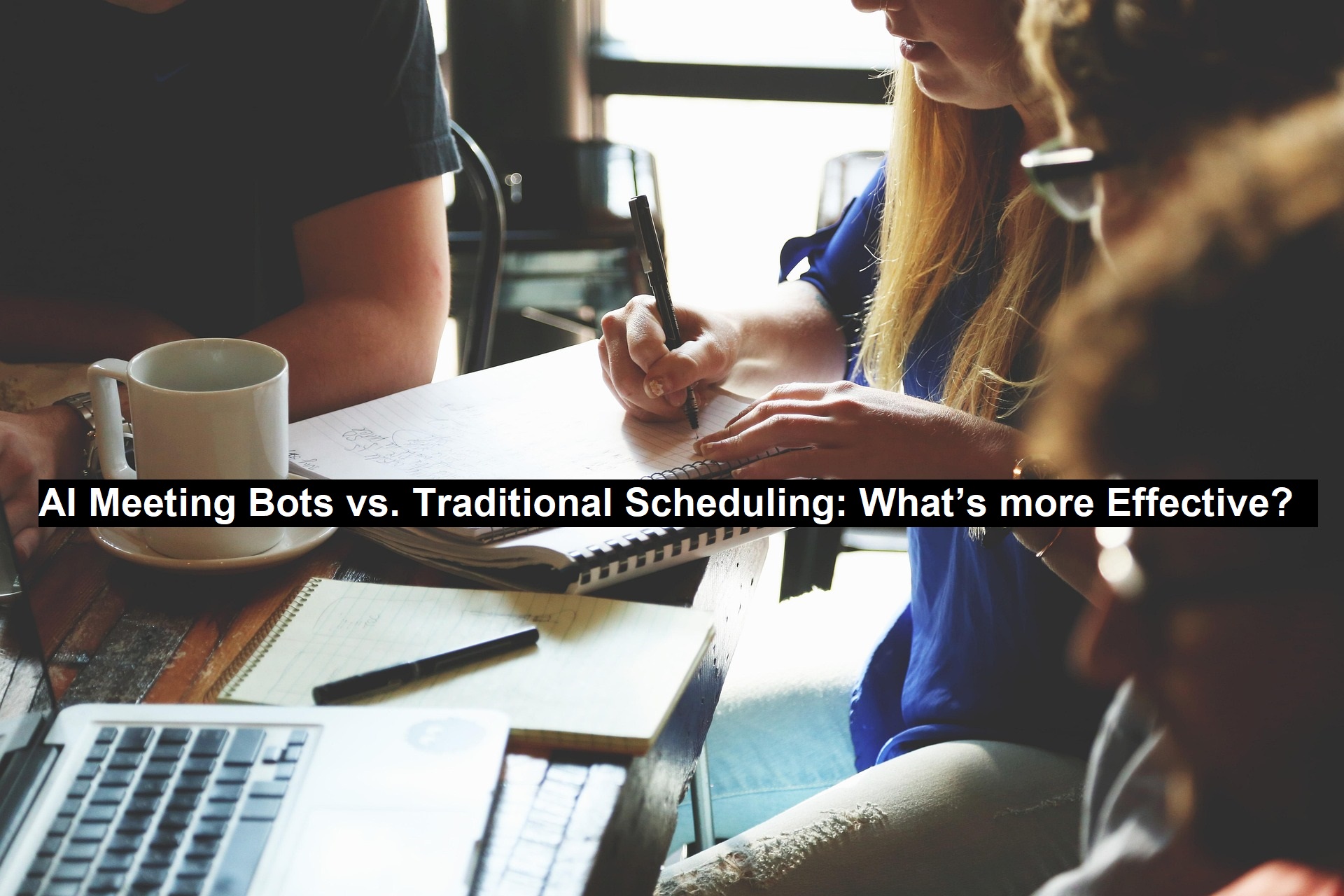We’ve all been there—endless email threads trying to nail down a time for a meeting. Between time zones, packed calendars, and last-minute changes, scheduling can feel like a full-time job in itself. But now, there’s a new player in town: the AI Meeting Bot.
So, how do these smart tools stack up against the old-school way of doing things? Let’s break it down and see what’s really more effective—AI meeting bots or traditional scheduling.
Traditional Scheduling: The Old Familiar Way
Traditional scheduling typically involves back-and-forth emails, phone calls, or maybe using tools like Google Calendar or Outlook. For small teams or simple meetings, this method often gets the job done.
But once you throw in multiple people, time zones, and shifting priorities, things can get messy—fast. Human error, forgotten emails, or double-booked slots become more common than you’d like.
Read: Salesforce Integration with NetSuite: A Step-by-Step Guide
Pros:
- Personalized, human touch
- Can be flexible if preferences are known
- Familiar process for most people
Cons:
- Time-consuming
- Prone to miscommunication
- Doesn’t scale well for large teams or high-volume scheduling
Enter the AI Meeting Bot
An AI Meeting Bot is essentially your smart, tireless scheduling assistant. It integrates with your calendar, understands your availability, and automatically finds the best time for all parties involved. Some even follow up, reschedule, and send reminders without you lifting a finger.
Think of it as your always-on scheduling sidekick—no coffee breaks needed.
What can it do?
- Access calendars and find open slots
- Schedule meetings with minimal input
- Reschedule automatically when conflicts arise
- Integrate with platforms like Slack, Zoom, Google Meet, and more
- Send reminders and follow-ups
Why AI Meeting Bots Are Gaining Traction
1. They Save Time (Lots of It)
Instead of sending five emails to book a 30-minute meeting, the AI meeting bot handles the entire process in seconds. It checks calendars, proposes times, and finalizes the meeting—all without disrupting your workflow.
2. They’re Available 24/7
No need to wait for someone to respond. These bots work around the clock, which is especially handy if you’re coordinating across different time zones.
3. Fewer Mistakes
Humans can miss things—double-booking or forgetting a calendar update, for example. AI bots reduce those mistakes because they work directly with real-time calendar data.
4. Seamless Integration
AI meeting bots work with the tools you already use—Google Calendar, Outlook, Slack, Microsoft Teams, and more. This makes them easy to adopt without a major learning curve.
5. A Smoother Experience for Everyone
Whether you’re the one booking or receiving the invite, AI scheduling usually feels more effortless. No back-and-forth, no confusion—just an invite with everything you need.
The Drawbacks (Because Nothing’s Perfect)
AI bots are amazing, but they’re not flawless:
- Lack of Human Touch: Sometimes you just need to make a judgment call or accommodate someone’s preference that a bot wouldn’t catch.
- Tech Dependence: If the bot doesn’t have updated data or access to your latest calendar changes, things can go wrong.
- Privacy Concerns: Granting access to your calendar and communication tools might make some users uneasy—especially in industries where confidentiality is key.
So… Is Traditional Scheduling Dead?
Not necessarily. In situations where personal relationships matter—think sales calls, client onboarding, or executive meetings—manual scheduling may still be preferred. It gives you more control and the opportunity to build rapport during the scheduling process.
That said, traditional scheduling just doesn’t scale well. For busy teams, global operations, or high volumes of meetings, it can quickly become inefficient and frustrating.
Head-to-Head Comparison
- Feature Traditional Scheduling AI Meeting Bot
- Time efficiency Moderate High
- Error rate Higher Lower
- Personalization High Moderate
- 24/7 Availability No Yes
- Scalability Low High
- Ease of use Familiar, but manual Automated, fast
Real-World Use Cases
- In the Corporate World:
Companies with large teams or global clients use AI meeting bots to save time and eliminate the scheduling hassle. - Healthcare Appointments:
AI tools can help book and manage appointments efficiently—improving the patient experience while lightening the load for front desk staff. - Education & Training:
Universities and training centers use bots to organize student meetings, workshops, and even interviews.
What’s Next for AI in Scheduling?
We’re only scratching the surface of what AI meeting bots can do. Soon, we’ll likely see even more advanced features like:
- Smart Meeting Summaries: Automatically generate notes or follow-ups.
- Voice Activation: “Hey bot, book a meeting with Sarah next week.”
- Predictive Scheduling: Bots that learn your habits and preferences over time to suggest the best days and times.
As AI continues to evolve, these tools will only become smarter and more intuitive.
Final Thoughts
So, what’s more effective—AI meeting bots or traditional scheduling? It really depends on your needs. If you value personal touch, work in a small team, or only schedule occasionally, traditional methods may still work fine. But if you’re drowning in meetings, coordinating across time zones, or just want to save hours each week, an AI Meeting Bot can be a game-changer.
At the end of the day, it’s not about replacing humans—it’s about freeing up time so we can focus on the work that really matters.
Author’s Bio:
Albert smith is a qualified content writer with experience in writing on a variety of subjects. He has written a lot of content on AI Workforce, AI Meeting Bots and AI Video Assistant services as well.

